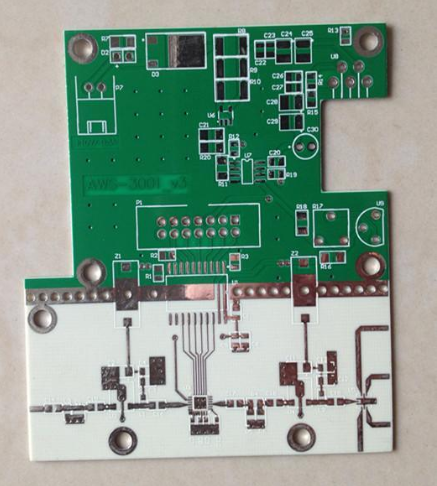FPC flexible circuit board through-hole methods are roughly divided into the following three types
1. CNC drilling
Most of the holes in the double-sided flexible printed board are still drilled with a CNC drilling machine. The CNC drilling machine and the CNC drilling machine used for the rigid printed board are basically the same, but the drilling conditions are different. Because the flexible printed circuit board is very thin, it is possible to overlap multiple pieces of drilling. If the drilling conditions are good, 10 to 15 pieces can be overlapped for drilling. The backing plate and cover plate can use paper-based phenolic laminate or glass fiber cloth epoxy laminate, or aluminum plate with a thickness of 0.2 to 0.4 mm. Drills for flexible printed boards are available on the market, and drills for drilling rigid printed boards and milling cutters for milling shapes can also be used for flexible printed boards.
The processing conditions for drilling, milling, and the shape of the reinforced board are basically the same. However, since the adhesive used in the flexible printed board material is soft, it is easy to adhere to the drill bit, and it is necessary to frequently check the state of the drill bit. And it is necessary to appropriately increase the speed of the drill bit. For the multi-layer flexible printed board or multi-layer rigid flexible printed board drilling should be particularly careful.

2. punching
Punching the micro-aperture is not a new technology, it has been used as a mass production. Since the reeling process is continuous production, there are many examples of using punching to process the through-holes of the reel. But batch punching technology is limited to punching diameter O. Compared with the drilling of the CNC drilling machine, the 6~0.8mm hole has a longer processing cycle and requires manual operation. Because the size of the initial process is large, the punching mold is correspondingly large, so the mold price is very expensive. Although mass production is beneficial to reducing costs, the burden of equipment depreciation is large, and small batch production and flexibility cannot compete with CNC drilling, so it is still not popular.
But in the past few years, great progress has been made in both the precision of the punching technology and the numerical control drilling. The practical application of punching on flexible printed boards has been very feasible. The latest PCB mold manufacturing technology can produce holes with a diameter of 75um that can punch 25um of the base material thickness of the non-adhesive copper clad laminate. The reliability of punching is also quite high, and it can even be punched if the punching conditions are right. 50um hole. The punching device has also been numerically controlled, and the mold can also be miniaturized, so it can be well used for punching flexible printed boards, and neither CNC drilling nor punching can be used for blind hole processing.
3. Laser drilling
The smallest through holes can be drilled with a laser. The laser drilling machines used to drill through holes on FPC include excimer laser drills, impact carbon dioxide laser drills, YAG (yttrium aluminum garnet) laser drills, and argon gas. Laser drilling machine, etc.
The impact carbon dioxide laser drill can only drill the insulating layer of the substrate, while the YAG laser drill can drill the insulating layer and copper foil of the substrate. The speed of drilling the insulating layer is significantly faster than that of copper foil. The speed is fast, and the production efficiency of all the drilling processes with only the same laser drilling machine can not be very high. Generally, the copper foil is etched first, the hole pattern is formed first, and then the insulating layer is removed to form the through hole, so that the laser can drill holes with extremely small apertures. However, at this time, the position accuracy of the upper and lower holes may restrict the hole diameter of the drilled hole. If it is to drill blind holes, as long as the copper foil on one side is etched away, there is no problem of up and down position accuracy. This process is similar to the plasma etching and chemical etching described below.